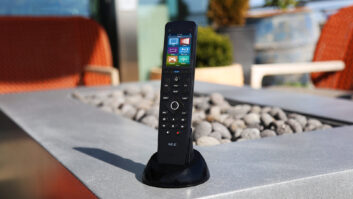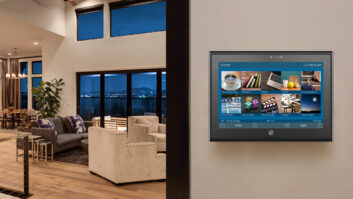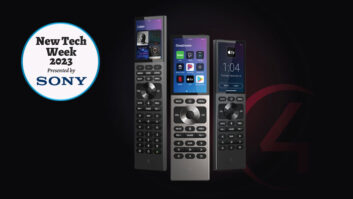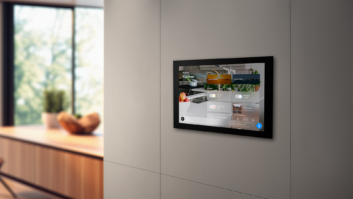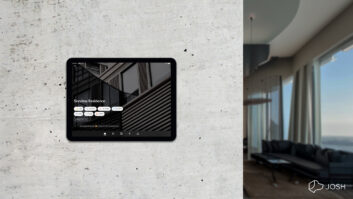With the industry approaching two years of testing and implementation of voice technology, there have been many lessons learned and best practices created to successfully integrate voice into a robust, professional smart home installation. To help you compare your own approach to those of your industry peers, we spoke with a bicoastal panel of four integrators, all of whom are involved in utilizing voice control in their home automation installations.

Helping us in this initiative were Joel Hernandez of First Priority Audio in Ft. Lauderdale, FL; Kyle Steele of Global Wave Integration in West Hills, CA; Mark Hoffenberg of AudioVisions in Lake Forest, CA; and Mike Stram and Brian Harding of Easy Living with Technology in Clearwater, FL.
‘It’s Not Right for Every Client’
Joel Hernandez of First Priority Audio is proud to be an early adopter of voice control, seeing it as the next and most logical step for control.
“What drew us to voice control is that ‘writing on the wall’ kind of thing. We knew that was the next step in all of this, so let’s get in front of it,” he said. “We actually tried to develop our own system for a while, but that was set aside as we tested available solutions.”
In fact, First Priority Audio has tested and rejected Amazon Alexa devices. “We’ve tried a lot of things, and most of it doesn’t work–at least not to the level of the systems that we are installing,” he said. “We’ve learned that we do not like Alexa, and we don’t play with Alexa.”
Alexa, it seems, did not work well with some of the other products that First Priority installs, such as motorized shades. So the company tested Google Home and discovered much better results, mostly because of the ability to customize phrasing for a command.
“I think we can put up three different phrases for the same command, which allows for some flexibility,” he said. “It’s just not as rigid as the Alexa system in that sense. We can also customize the feedback or the response, so the customer actually hears feedback that we can customize to say whatever we want. And the client can even issue commands from his phone, such as issuing the command to open the garage door as he’s pulling into his driveway.”
Hernandez said that the number of First Priority Audio systems installations that include voice control is still pretty low as his team continues to make adjustments to their implementations. And, the company is “not actively marketing or pushing it just yet.” First Priority Audio tries to discourage some clients from adding it, while for others they’ll go ahead and deploy it without hesitation, due to their tech-savvy nature.
“The right client is somebody who really likes technology, a guy who’s a cutting-edge/first-adopter kind of person,” Hernandez explained. “It’s somebody who understands the limitations of the technology, so that when they say ‘Turn on the TV’ and it doesn’t come on…they don’t flip out. It’s not right for every client.”

In other words, “This is not Jarvis from the Iron Man movie,” Hernandez said he tells clients. Clients need to understand that “this isn’t going to be perfect out of the box, and we’re all kind of learning as we go along.”
Hernandez also strives to involve the client early in the process, learning how and where they want to use voice as the control mechanism. Also, because Google Home allows custom commands and responses, it pays to get clients involved earlier in the process to help select the commands that make sense to them. “We ask the client, ‘If you were to turn on the lights here by your voice, what would you want to say or how would you want to say it?’ so we can use the client’s chosen phrases,” he explained.

Most importantly, Hernandez said, clients need to understand that their voice goes into the device and then out over the internet, with the resulting action sent back to their system, before anything happens. If the internet is down or slow, it might take some time to execute or fail at that moment. In that instance, there are other control interfaces, such as remotes, keypads, or touchscreens, to use.
“Ultimately, we’re still using a DIY product to control a professional-grade system, and inherently, there’s a problem there,” Hernandez said.
Useful for Only Fairly Simple Things
Like First Priority Audio, AudioVisions is still in the early stages of including voice control in client installations. AudioVisions co-founder Mark Hoffenberg said that voice control is still “a pretty new technology,” and the company has only deployed it in about 20 installations so far–a fairly small number as compared to their total installed base.
In explaining the care and caution that AudioVisions is taking in its approach to integrating voice control, Hoffenberg asked, “Are you impressed with the voice control in your car? I didn’t think so. Keep in mind a car is a very controlled environment and the car companies have more money to spend than almost anyone else. Yet even they can’t get voice control right at this point.”

Yet, Hoffenberg still sees voice control as a fairly large opportunity, while noting that the “AI needs to improve significantly before it meets general client expectations.”
Currently, AudioVisions is using Alexa devices integrated with Savant, Crestron, Lutron, and Sonos systems. The company is looking into other solutions as well, such as Josh.ai. Hoffenberg said that it’s all being done on a fairly limited basis with steps taken to manage client expectations–keeping them low to avoid dissatisfaction.
So how does AudioVisions utilize voice control in its installations? “In its current state of infancy, voice control is useful for only fairly simple things,” Hoffenberg suggested. “This is because the specific language needed is too precise and too limiting. Fortunately, companies like Josh.ai are working on solutions to these problems.”
Hoffenberg urged that integrators shouldn’t overpromise on voice control. It’s fine to be enthusiastic about a voice interface and the ease that it potentially represents for the client, but you don’t want to set yourself up for a dissatisfied client when the system inevitably falls short.
Hoffenberg said that given the state of the technology today, “Voice control should augment other forms of control and should not be the only method to control most things. In other words, it should be an additional UI layer.”
AudioVisions also takes steps to make sure “clients are OK with always-on microphones around their home, and have a clear understanding of a device’s impact on network security.” This is especially important where the client has no experience with Alexa and may not fully understand how the systems work and what is involved.
Smart Speakers Can Lead to Frustration
Global Wave Integration has been involved with voice control for several years now, even before the emergence of Amazon Alexa. Company president Kyle Steele said it is currently installing voice control in approximately 50 percent of its installations, noting that the breakdown is due strictly to client choice. It offers voice control to pretty much everybody, but some clients opt not to go with it.
Steele noted that while some clients express frustration that Alexa-based systems do not always recognize or understand their spoken commands, he is optimistic that voice systems will continue to improve and become more refined, such as utilizing natural language for system input rather than clients having to memorize specially worded commands.
“Once natural language programming happens, adoption is going to go through the roof,” Steele said.
Global Wave Integration continues to test all available voice systems on the market, but is mostly installing Amazon Alexa devices and Josh.ai solutions. He said Alexa is the predominant choice, as many of their clients already own an Amazon device they want integrated with the systems. Also, Alexa works well with their Savant and Crestron brands.
The biggest challenges, he said, are not hardware or software related, but come from the client. “Wake words, accents, and exact phrases are the biggest challenges we face,” Steele said. “The need for memorization of specific commands and instructions limits the client engagement currently. To counter this we’ve printed off ‘cheat sheets’ of command instructions to help our clients.”
Global Wave did an installation at a large estate in Beverly Hills that had a lot of scenes in a house that is fully automated, “So at bedside there is a whole 8.5-by-11-inch sheet of commands,” Steele said. “The client looks at the cheat sheet and said, ‘I don’t want to have to remember all these different commands.’ And, you have to say the phrase dead on, or nothing happens…Alexa doesn’t understand you.”
Steele never pitches voice control to clients as a first point of control because it would be frustrating for them. He feels that voice control is fine for recalling scenes, but “not optimal” for changing channels. “Most of our clients still prefer the tactile feedback of a remote control,” he said.
Global Wave avoids placement of a voice control device near a TV or loudspeaker, because an Alexa device located near the sound emanating from speakers or TVs can reduce the effectiveness of the far-field microphone array. Instead, the company tries to place the voice control device on a bedside table for “peace of mind to easily manually mute the device and turn off the microphone.”
In spite of the sometimes-vexing challenges of the technology, Steele remains optimistic about voice control’s future.
“The best interface is one that you can use with your eyes closed,” he declared. “And that’s what voice control allows us to do.”

‘It’s So Cool’
Mike Stram of Easy Living with Technology had a strong reaction to the suggestion that our industry is fully two years into integrating voice control into home automation systems. “I think that’s premature,” he said emphatically. “I think we’re barely scratching the surface. We are in the infancy of voice control.”
Easy Living with Technology is one of the most prolific integrators at installing home automation solutions that include voice control technology. But it didn’t start out that way.
“When voice control first came out two years ago, I was very leery of it–if not afraid of it,” Stram said. “We had just really adopted Savant as our number-one control vendor, and now, here comes Alexa nipping at the heels of this foundation that our business was built upon.”
But Stram spoke with one of his tech-savvy clients, who convinced him to not look at Alexa as a replacement for Savant, but rather as “another window or doorway into the system.” He said that his company installs systems based on Savant control and Vantage lighting. Savant, he explained, has made it incredibly simple to create scenes–even by the client–that can be instantly discovered by Alexa and controlled.
“Clients can put the app on their phone and without any custom programming whatsoever, in a Savant and Vantage lighting automation home, be able to say, ‘Hey Alexa, make the lights 20 percent’ and she says ‘OK’ and boop, it happens. And there isn’t a single line of code necessary.”
Stram admitted that two years ago, if he heard that it was possible for a client to do this with no interaction with the Easy Living With Technology team, he would have been upset. But now, he said, “It’s so cool.”
“I mean its kudos to Savant,” Stram added. “The idea that Savant makes it so easy that the user can make their own custom scenes and personalize it by naming it whatever makes sense to them is so smart. And the client is going to remember the scene, because they named it.”
That ease of installation gave Stram an idea. “You know because it’s so easy and inexpensive, I’m using it as a freebie,” Stram said, referring to the Amazon Dot. “I simply include it for free as an enhancement to the installation–although it depends somewhat on the client. A lot of people do not like the idea of having a live microphone in their house 24/7.”
To make the experience more fluid, Stram’s company downloads and installs apps for its clients. He said that it is “unbelievable” how many times he asked for the client’s phone to install an app for them “and you look at their phone, and they aren’t even connected to their own Wi-Fi! So you have to show them how to use ‘Settings’ on their own phone.”
Stram also believes that integrators must manage client expectations because “there’s no standard of what a client has for their personal expectations of what they’re buying or what they’re getting. Laying the foundation of what that is and what it is not is part of the education process of the sale,” he said.


